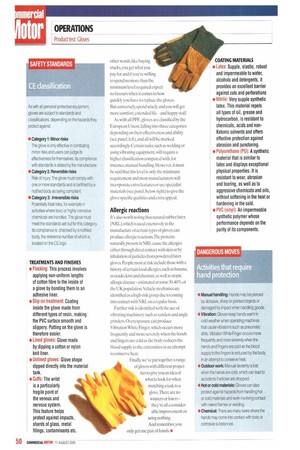CONIPMTIVIENT
Page 48

Page 50

If you've noticed an error in this article please click here to report it so we can fix it.
Only a fool fails to wear protective equipment and in the road haulage industry there are plenty of potential hazards to handle.
As Max Hygraves once said," You need hands", though whether he was talking about the road transport industry we'll never know.This particular environment entails the use of, and if not looked after correctly the abuse of, these most practical of body parts.
The hand has 27 bones and 40 musclesit's also the most nerve-rich part of the body. Exertion causes it to perspire and exposes it to muscular fatigue that can lead to certain diseases.More than a third of workdr _ accidents affect the j-1 related industrial 1.--hands, but its _...
estimated that 80% of C. these could be avoided. While the law demands that protective standards are met when handling certain goods or completing certain tasks, there are a number ofjobs, such as manual handling, where a decent set of gloves can also avoid the possibility of an accident and therefore sick leave/compensation/material damage. In other words, your company's bottom line. The Health and Safety Executive states: "Every employer shall ensure that suitable personal protective equipment (PPE) is provided to their employees who may be exposed to a risk to their health and safety while at work."
However, it's one thing leading a horse to water and it's another getting it to wear the stuff, For instance, the more a glove protects the hand. the more it hinders movement and the more likely it is to become uncomfortable.
Hence the fact that many people work without gloves, despite legislation. Human negligence nearly always plays a part in accidents at work, but choosing the correct glove and also one thaescomfortable to wear means users will more readily agree to use it continuously.
So what to choose? The decision should be made on the basis of suitability for protection, compatibility with the work involved and the requirements of the user (see panel, right). You should also consider the ability of protective gloves to resist abrasion and other industrial wear and tear to ensure longevity. In other words, like buying trucks, you get what you pay for and if you're willing to spend no more than the minimum level required expect no favours when it comes to how quickly you have to replace the gloves. But conversely, spend wisely and you will get more comfort, extended life —and happy staff.
As with all PPE, gloves are classified by the European Union, falling into three categories depending on their effectiveness and ability (see panel, left), and all will be marked accordingly. Certain tasks, such as welding or using vibrating equipment, will require a higher classification compared with, for instance, manual handling. However, it must be said that this level is only the minimum requirement and most manufacturers will incorporate extra features or use specialist materials (see panel, below right) to give the glove specific qualities and extra appeal.
Allergic reactions It's also worth noting that natural rubber latex (NRL), which is used extensively in the manufacture of certain types of gloves, can produce allergic reactions.The proteins naturally present in NRL cause the allergies either through direct contact with skin or by inhalation of particles from powdered latex gloves. People most at risk include those with a history of certain food allergies,such as banana, avocado, kiwi and chestnut, as well as atopic allergic disease — estimated at some 30-40% of the UK population. Vehicle mechanics are identified as a high-risk group due to coming into contact with NRL on a regular basis.
Further risk is identified with the use of vibrating machinery such as sanders and angle grinders. Overexposure can produce Vibration White Finger, which occurs more frequently and more severely when the hands and fingers are cold as the body reduces the blood supply to the extremities in an attempt to conserve heat.
Fmally.we've put together a range of gloves with different properties to give you an idea of what to look for when matching a task to a glove.There are no winners or losers — they're all a considerable improvement on using nothing.
And retnember,you only get one pair of hands. •


































































































































































































